UHF RFID-Based Vehicle Navigation on Straight Unpaved Road Reinforced with Geocell
Abstract
1. Introduction
2. Related Work
3. Overview of the Vehicle Navigation System
3.1. Integration of RFID Tag Data with Navigation Guidance Method
3.2. Navigation Guidance Method [2]
3.3. GUI
- The two black rectangles show front wheels. The direction of the front wheels is displayed with respect to the movement of the vehicle. The tire angle is calculated using the steering wheel angle. The relationship between the steering wheel angle and front tire angle is measured in advance. This is linked to the steering wheel, which controls the front wheels and indicates the extent to which they rotate, thereby reflecting the degree to which the steering wheel turns.
- The green arrowhead indicates the relative direction and the lateral vehicle position in the lane. The arrowhead rotates when the direction of the vehicle changes.
- Red text displays the information about the road on which the vehicle is currently traveling.
- The blue bar shows the current speed of the vehicle.
- The number at the top of the display indicates the current speed, whereas the number at the bottom represents the speed limit.
- This value is the difference between the actual and optimal steering wheel angles.
- The orange arrow indicates the difference between the angles on the steering wheel given on item 6. To correct the vehicle’s direction, the driver should adjust the steering until the red triangle aligns with the orange arrow.
- The small red triangle on the steering wheel represents its current position. This virtual steering wheel is linked to actual vehicle steering via the multi-rotate potentiometer on the steering wheel shaft.
3.4. Fixing RFID Tags on the Road
4. Proposed Methodology
4.1. Geocells
Fillers
4.2. Fixing RFID Tags on Geocells
4.2.1. Low-Density Filler (Crushed Stone No. 5)
4.2.2. High-Density Filler (Crushed Stone C-40)
4.3. Communication Range
4.3.1. Measuring the Communication Range
4.3.2. Communication Range on Paved Roads
4.3.3. Communication Range on Unpaved Roads
5. Experimental Field
6. Driving Experiment
6.1. Vehicle Heading Angle Correction Method
6.2. Driving Experiment Performed Using the New Vehicle Heading Angle Correction Method
7. Conclusions
Author Contributions
Funding
Institutional Review Board Statement
Informed Consent Statement
Data Availability Statement
Acknowledgments
Conflicts of Interest
Abbreviations
| GPS | Global Positioning System |
| RFID | Radio Frequency Identification |
| RF | Radio Frequency |
| LiDAR | Light Detection and Ranging |
| SLAM | Simultaneous Localization and Mapping |
| UHF | Ultrahigh Frequency |
| INS | Inertial Navigation System |
| LCD | Liquid Crystal Display |
| GUI | Graphical User Interface |
| HDPE | High-Density Polyethylene |
| PVC | Polyvinyl Chloride |
| CIs | Confidence Interval |
References
- Kawamura, T.; Kashiwa, T.; Taguchi, K. Vehicle navigation system using UHF RF-ID. Eur. Transp. Res. Rev. 2013, 5, 91–99. [Google Scholar] [CrossRef]
- Morita, R.; Kawamura, T. Vehicle navigation using UHF RFID system under low visible condition caused by heavy snowfall—Development of four antenna system. In Proceedings of the 2021 International Workshop on Modern Science and Technology, Kitami, Japan, 29 September 2021; pp. 51–56. [Google Scholar]
- Hokkaido Prefectural Government. Available online: https://www.pref.hokkaido.lg.jp/ss/tuk/920hsy/114632.html (accessed on 10 July 2024).
- Book Baker. Available online: https://www.bookbaker.com/tr/v/Geocell-A-Comprehensive-Guide-for-Construction-Introduction-to-Geocell-Technology/8a5ad138-3de6-469b-bf52-0c03fe0721d7/1 (accessed on 15 November 2023).
- Martins, C.; Macedo, J.; Pinho-Lopes, M. Geocells for Unpaved Roads: Analysis of Design Methods from the Literature. Int. J. Geosynth. Ground Eng. 2024, 10, 57. [Google Scholar] [CrossRef]
- Yamaha Motor Co., Ltd. Available online: https://www.yamaha-motor.co.jp/gsm/ (accessed on 20 June 2024).
- Omae, M.; Hirano, S.; Kamisaka, T. Study on Measurement of Lateral Displacement for Vehicles Traveling on Road with Electromagnetic Guidance. J. Soc. Automot. Eng. Jpn. 2022, 53, 591–597. [Google Scholar]
- Ando, T.; Mukumoto, H.; Aoki, K.; Okazaki, S.; Nagao, T.; Aoyama, H.; Yamamoto, M.; Nakano, K. Localization using global magnetic positioning system for automated driving bus and intervals for magnetic markers. IEEE Trans. Intell. Veh. 2022, 8, 878–887. [Google Scholar] [CrossRef]
- Ishii, K.; Shimono, K.; Suda, Y.; Ando, T.; Nagao, T.; Yamamoto, M.; Segawa, M. Vehicle localization using magnetic markers incorporating EKF and maximum likelihood estimation. IFAC-PapersOnLine 2022, 55, 202–207. [Google Scholar] [CrossRef]
- Chen, R.; Huang, X.; Zhou, Y.; Hui, Y.; Cheng, N. UHF-RFID-Based Real-Time Vehicle Localization in GPS-Less environments. IEEE Trans. Intell. Transp. Syst. 2021, 23, 9286–9293. [Google Scholar] [CrossRef]
- Wang, J.; Ni, D.; Li, K. RFID-Based Vehicle Positioning and Its Applications in Connected Vehicles. Sensors 2014, 14, 4225–4238. [Google Scholar] [CrossRef] [PubMed]
- Chon, H.; Jun, S.; Jung, H.; An, S. Using RFID for Accurate Positioning. J. Glob. Position. Syst. 2004, 3, 32–39. [Google Scholar] [CrossRef]
- Das, P.; Agrawal, D.P. RFID for indoor position determination. In Smart Innovation, Systems and Technologies; Springer Nature: London, UK, 2014; pp. 561–567. [Google Scholar] [CrossRef]
- D’Mello, S.; Mathews, E.; McCauley, L.; Markham, J. Impact of position and orientation of RFID tags on real time asset tracking in a supply chain. J. Theor. Appl. Electron. Commer. Res. 2008, 3, 1–12. [Google Scholar] [CrossRef]
- Wang, Z.M.; He, B.Q. RFID Location Algorithm. MATEC Web Conf. 2016, 63, 05007. [Google Scholar] [CrossRef]
- Ajroud, C.; Hattay, J.; Machhout, M. A novel holographic technique for RFID localization in indoor environments. Multimed. Tools Appl. 2023, 83, 29827–29840. [Google Scholar] [CrossRef]
- Charléty, A.; Breton, M.L.; Larose, E.; Baillet, L. 2D Phase-Based RFID Localization for On-Site Landslide Monitoring. Remote Sens. 2022, 14, 3577. [Google Scholar] [CrossRef]
- Ting, S.; Kwok, S.; Tsang, A.H.; Ho, G.T. The study on using passive RFID tags for indoor positioning. Int. J. Eng. Bus. Manag. 2011, 3, 8. [Google Scholar] [CrossRef]
- Motroni, A.; Buffi, A.; Nepa, P. A survey on indoor vehicle localization through RFID technology. IEEE Access 2021, 9, 17921–17942. [Google Scholar] [CrossRef]
- Shen, E.; Duan, S.; Guo, S.; Yang, W. Object localization and sensing in Non-Line-of-Sight using RFID tag matrices. Electronics 2024, 13, 341. [Google Scholar] [CrossRef]
- Laconte, J.; Kasmi, A.; Aufrère, R.; Vaidis, M.; Chapuis, R. A survey of localization methods for autonomous vehicles in highway scenarios. Sensors 2021, 22, 247. [Google Scholar] [CrossRef] [PubMed]
- Kamijo, S.; Gu, Y.; Hsu, L. Autonomous Vehicle Technologies: Localization and Mapping. IEICE ESS Fundam. Rev. 2015, 9, 131–141. [Google Scholar] [CrossRef]
- Levinson, J.; Thrun, S. Robust vehicle localization in urban environments using probabilistic maps. In Proceedings of the 2010 IEEE International Conference on Robotics and Automation, Anchorage, AK, USA, 15 July 2010; pp. 4372–4378. [Google Scholar] [CrossRef]
- Cheng, J.; Zhang, L.; Chen, Q.; Hu, X.; Cai, J. A review of visual SLAM methods for autonomous driving vehicles. Eng. Appl. Artif. Intell. 2022, 114, 104992. [Google Scholar] [CrossRef]
- Norris, W. Steering. In Modern Steam Road Wagons; Longmans, Green and Co.: London, UK, 1906; pp. 63–67. [Google Scholar]
- Lu, Y.; Wang, W.; Bai, R.; Zhou, S.; Garg, L.; Bashir, A.K.; Jiang, W.; Hu, X. Hyper-relational interaction modeling in multi-modal trajectory prediction for intelligent connected vehicles in smart cities. Inf. Fusion 2024, 114, 102682. [Google Scholar] [CrossRef]
- Ullah, I.; Singh, S.K.; Adhikari, D.; Khan, H.; Jiang, W.; Bai, X. Multi-Agent Reinforcement Learning for task allocation in the Internet of Vehicles: Exploring benefits and paving the future. Swarm Evol. Comput. 2025, 94, 101878. [Google Scholar] [CrossRef]

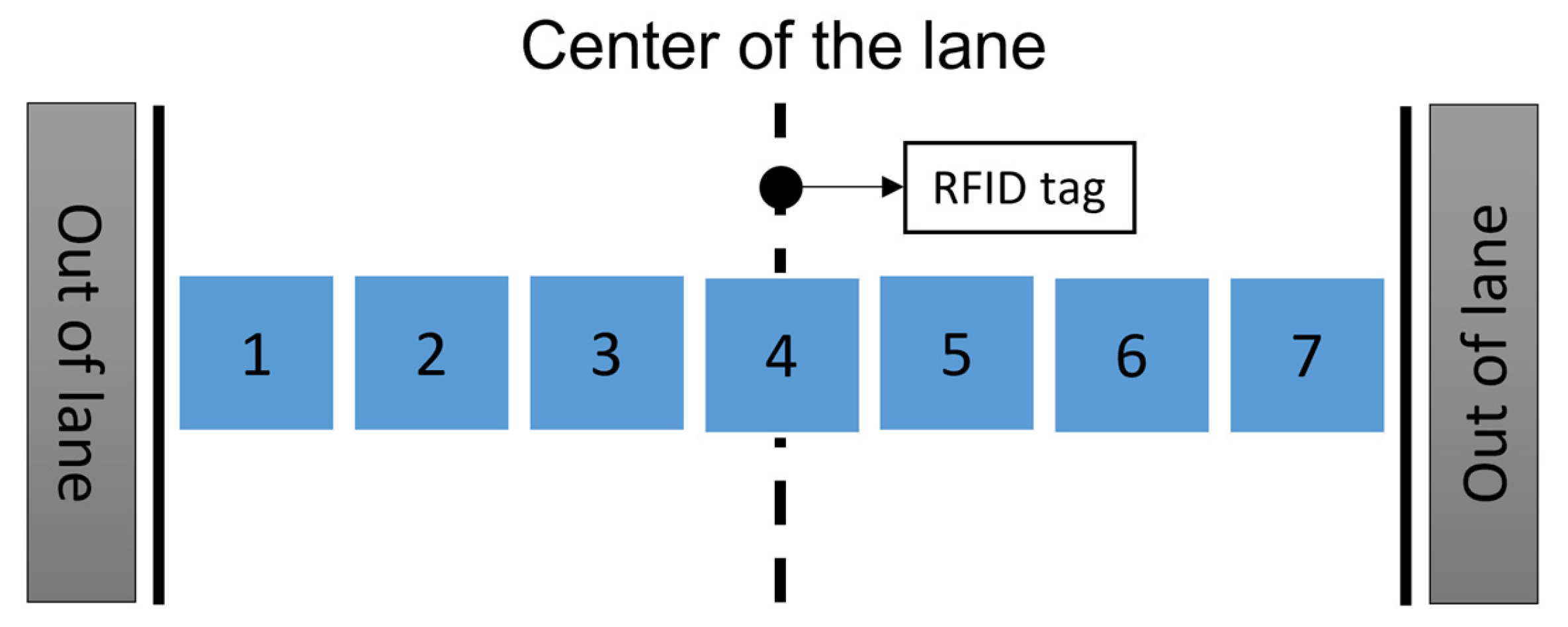


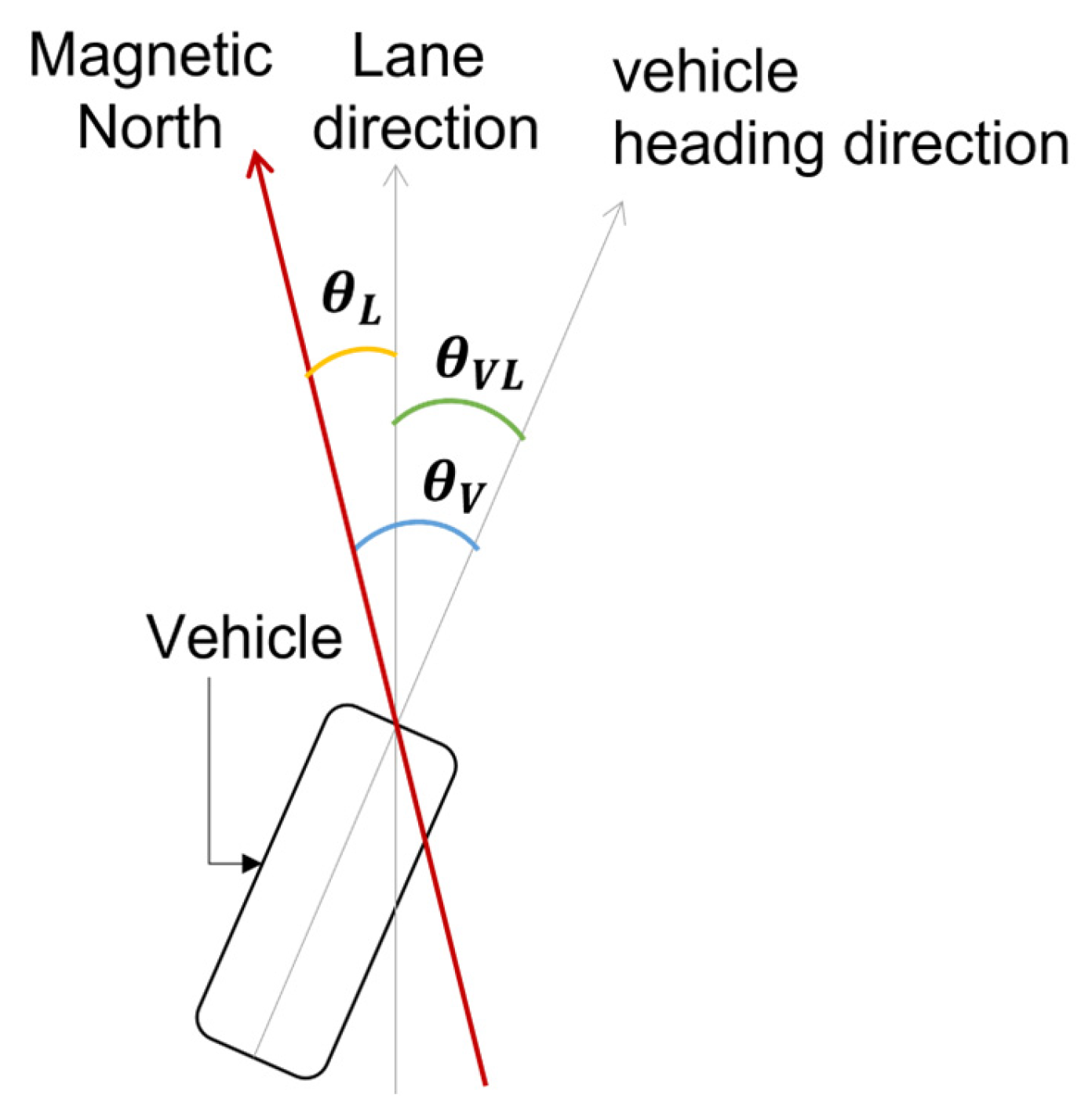





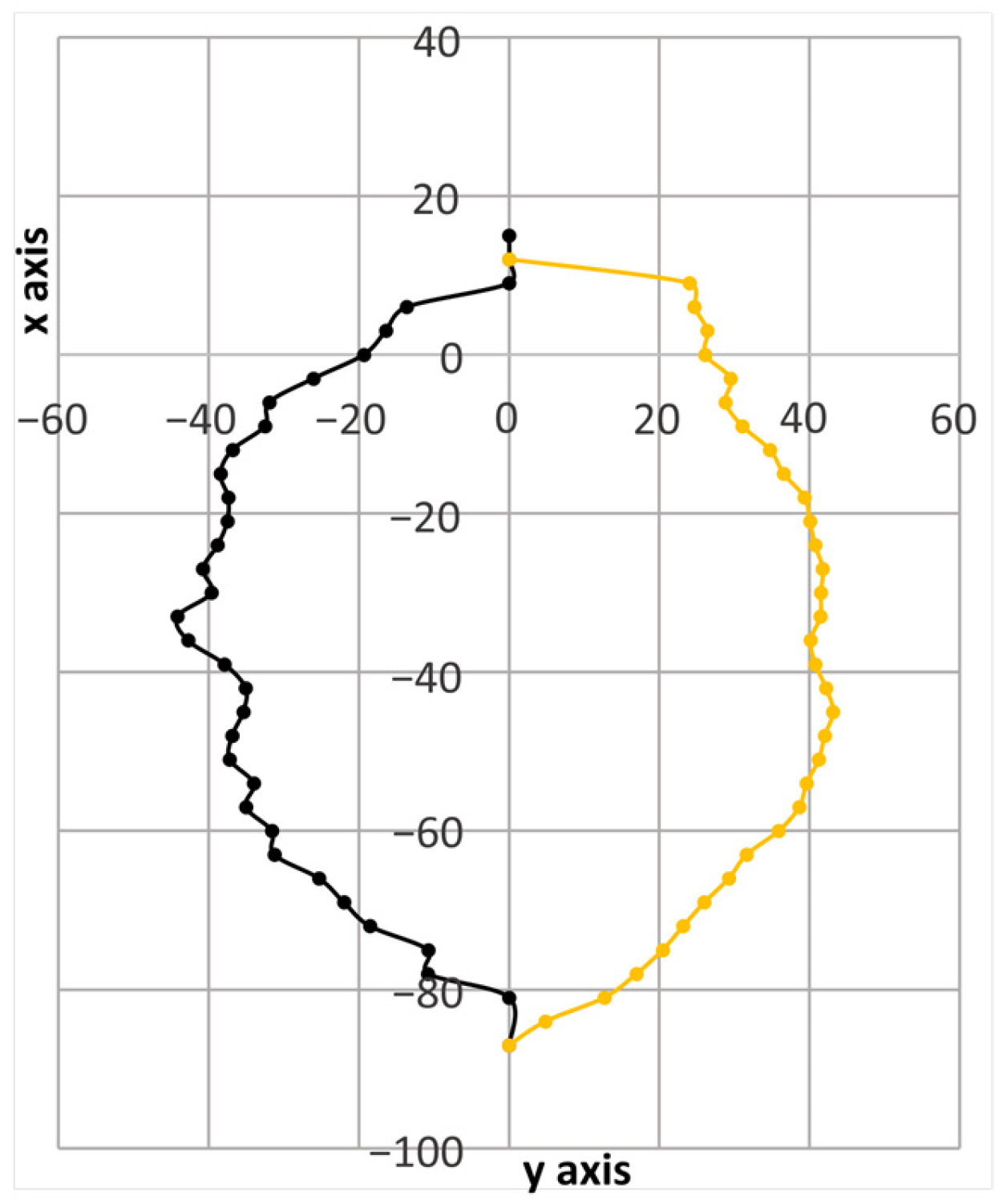





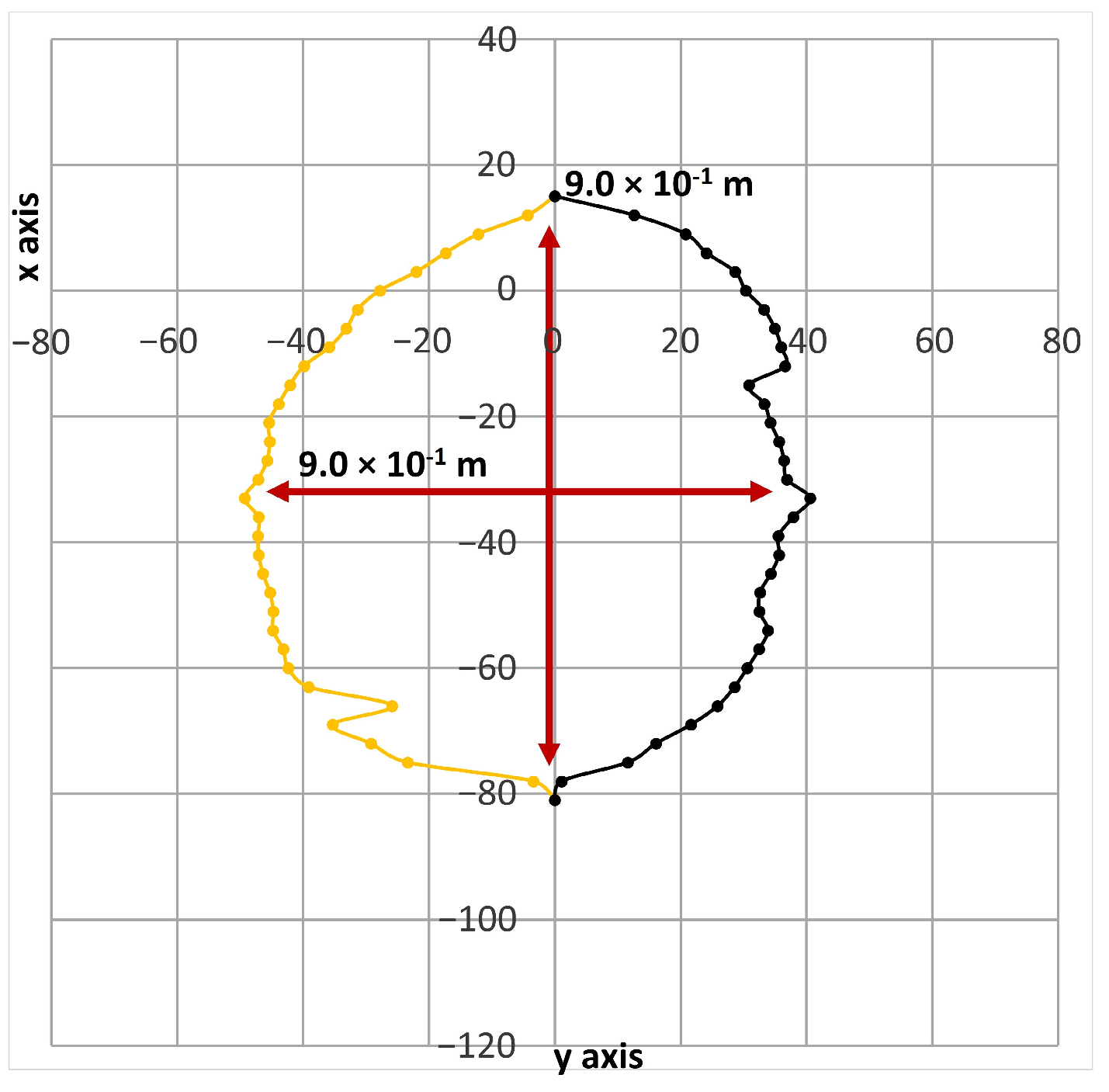


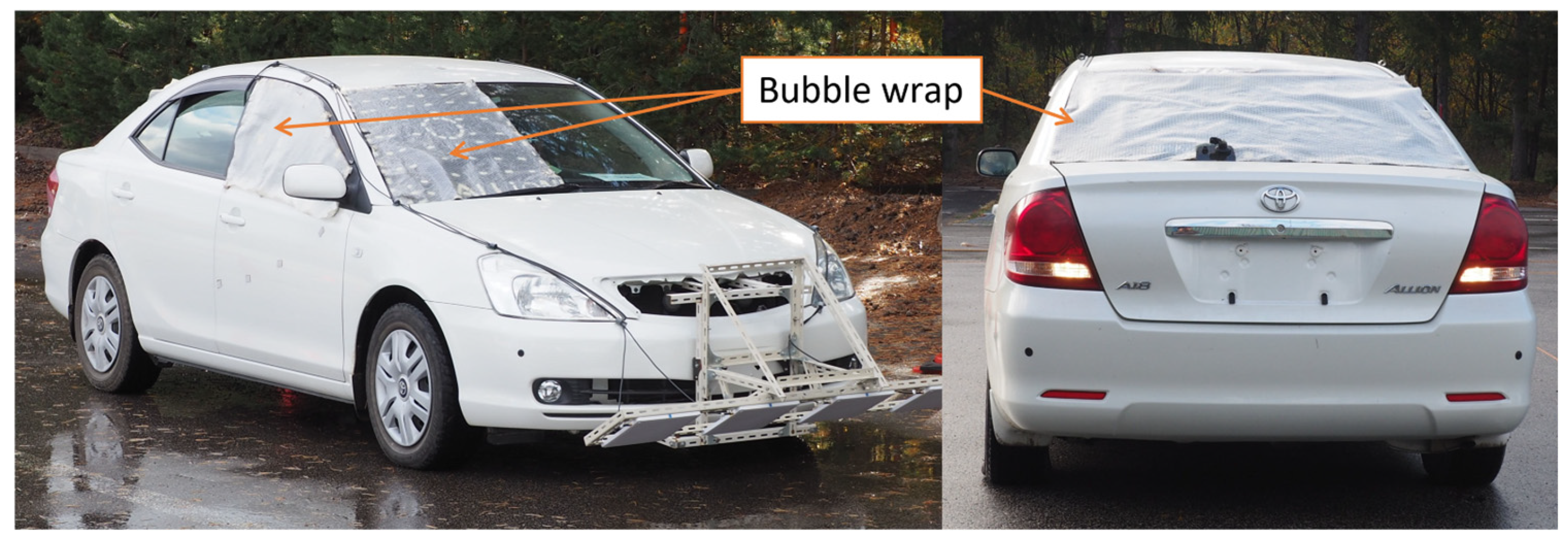
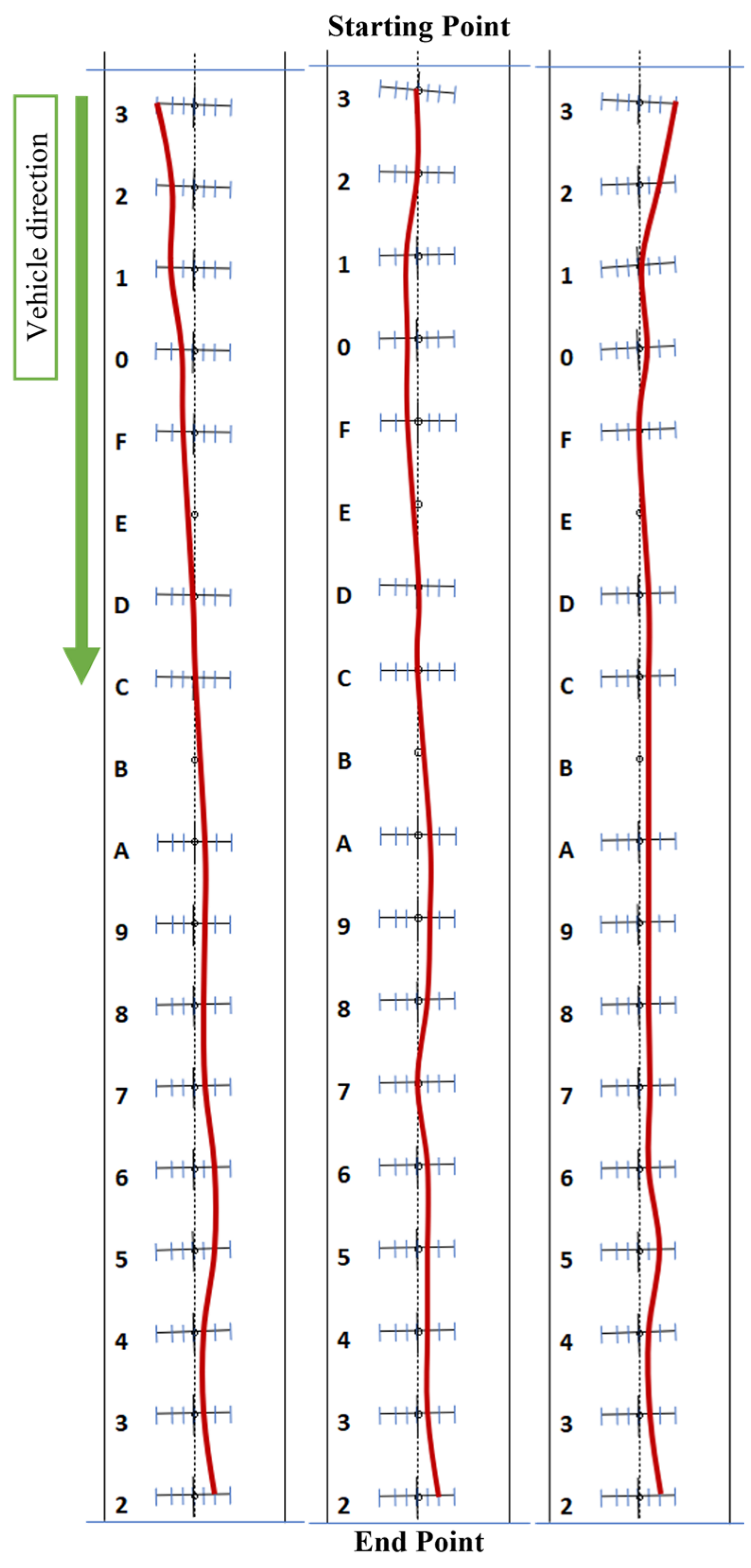

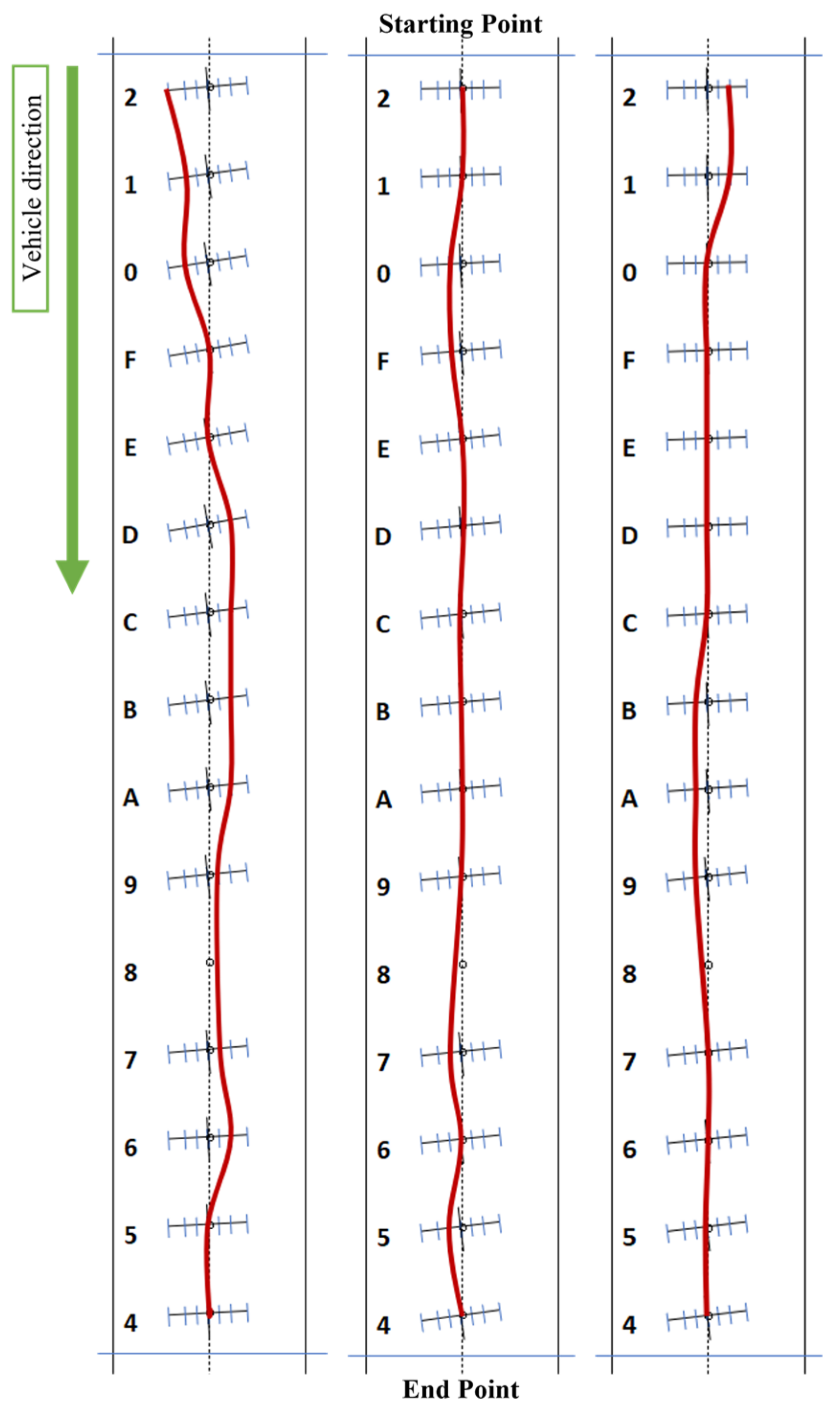
| Position | Reading Antennas | Estimated Distance d [m] Between the RFID Tag and the Vehicle Center |
|---|---|---|
| 1 | Only Antenna 4 | +0.7125 |
| 2 | Antenna 3 and Antenna 4 | +0.4125 |
| 3 | Only Antenna 3 | +0.2 |
| 4 | Antenna 3 and Antenna 2 | 0 |
| 5 | Only Antenna 2 | −0.2 |
| 6 | Antenna 2 and Antenna 1 | −0.4125 |
| 7 | Only Antenna 1 | −0.7125 |
| Tag Digit | Type of Information | Stored Information |
|---|---|---|
| 1 | , Tangent Line direction | Lane direction relative to magnetic north. On paved curved roads and intersection it is the tangent line direction. |
| 2 | ||
| 3 | Road Type | Straight Line: 0, 30 m before intersection: 1, Intersection: 3, Right curve: 4, Left curve: 5, 30 m before curves: 6, 7 |
| 4 | Sequence number | Sequential identifier of the tag (Repeat from 0 to F recursively) |
| 5 | Horizontal position | Lateral placement of the tag (1, 2, 3) (For a 4-antenna system [2] we use 2 for the lane center in this study) |
| 6 | Turning radius | Radius of curvature for curves and intersections |
| 7 |
| Filler | Antenna Output [dBm] | Comm. Range (Ø) [m] | |
|---|---|---|---|
| 1 | Crushed stone No. 5 | 24 | 9.37 × 10−1 |
| 2 | data | 22 | 7.99 × 10−1 |
| Case | Filler | Antenna Output [dBm] | Comm. Range (Ø) [m] |
|---|---|---|---|
| 1 | Crushed stone C-40 | 30 | 1.159 |
| 2 | 26 | 8.05 × 10−1 | |
| 3 | 26 | 9.0 × 10−1 |
| Position | Diameter of Communication Range [m] | ||
|---|---|---|---|
| 8.0 × 10−1 | 8.5 × 10−1 | 9.0 × 10−1 | |
| 1 | +0.7 | +0.7125 | +0.725 |
| 2 | +0.4 | +0.4125 | +0.425 |
| 3 | +0.2 | +0.2 | +0.2 |
| 4 | 0 | 0 | 0 |
| 5 | −0.2 | −0.2 | −0.2 |
| 6 | −0.4 | −0.4125 | −0.425 |
| 7 | −0.7 | −0.7125 | −0.725 |
| RFID Tag Deviation [m] | |||
|---|---|---|---|
| Left Side | Right Side | Entire Lane | |
| Maximum | 4.3 × 10−2 | 5.8 × 10−2 | 5.8 × 10−2 |
| Minimum | 8.0 × 10−3 | 3.0 × 10−3 | 0 |
| Standard deviation | 1.45 × 10−2 | 1.83 × 10−2 | 1.74 × 10−2 |
| Average | 2.84 × 10−2 | 1.92 × 10−2 | 2.15 × 10−2 |
| 95% CI | [1.98 × 10−2, 3.697 × 10−2] | [7.86 × 10−3, 3.05 × 10−2] | [1.43 × 10−2, 2.86 × 10−2] |
| Unpaved Road | Paved Road | ||
|---|---|---|---|
| Vehicle Heading Angle Correction Method | No Vehicle Heading Angle Correction [2] | ||
| Before | After | ||
| Total Trails | 31 | 102 | 126 |
| Lane out incident | 1 | 0 | 0 |
| Minimum deviation [m] | 0 | 0 | 2.5 × 10−2 |
| Maximum deviation [m] | 5.4 × 10−1 | 1.5 × 10−1 | 2.5 × 10−1 |
| Standard deviation [m] | 1.59 × 10−1 | 3.73 × 10−2 | 1.55 × 10−1 |
| Average deviation [m] | 1.376 × 10−1 | 4.46 × 10−2 | 5.46 × 10−2 |
| 95% CI [m] | [8.16 × 10−2, 1.93 × 10−1] | [3.73 × 10−2, 5.18 × 10−2] | [2.75 × 10−2, 8.16 × 10−2] |
Disclaimer/Publisher’s Note: The statements, opinions and data contained in all publications are solely those of the individual author(s) and contributor(s) and not of MDPI and/or the editor(s). MDPI and/or the editor(s) disclaim responsibility for any injury to people or property resulting from any ideas, methods, instructions or products referred to in the content. |
© 2025 by the authors. Licensee MDPI, Basel, Switzerland. This article is an open access article distributed under the terms and conditions of the Creative Commons Attribution (CC BY) license (https://creativecommons.org/licenses/by/4.0/).
Share and Cite
Castro Gonzalez, G.M.; Kawaguchi, T.; Nakamura, D.; Kurokawa, K.; Kawamura, T. UHF RFID-Based Vehicle Navigation on Straight Unpaved Road Reinforced with Geocell. Future Transp. 2025, 5, 143. https://doi.org/10.3390/futuretransp5040143
Castro Gonzalez GM, Kawaguchi T, Nakamura D, Kurokawa K, Kawamura T. UHF RFID-Based Vehicle Navigation on Straight Unpaved Road Reinforced with Geocell. Future Transportation. 2025; 5(4):143. https://doi.org/10.3390/futuretransp5040143
Chicago/Turabian StyleCastro Gonzalez, Gabriela Maria, Takayuki Kawaguchi, Dai Nakamura, Kenji Kurokawa, and Takeshi Kawamura. 2025. "UHF RFID-Based Vehicle Navigation on Straight Unpaved Road Reinforced with Geocell" Future Transportation 5, no. 4: 143. https://doi.org/10.3390/futuretransp5040143
APA StyleCastro Gonzalez, G. M., Kawaguchi, T., Nakamura, D., Kurokawa, K., & Kawamura, T. (2025). UHF RFID-Based Vehicle Navigation on Straight Unpaved Road Reinforced with Geocell. Future Transportation, 5(4), 143. https://doi.org/10.3390/futuretransp5040143




